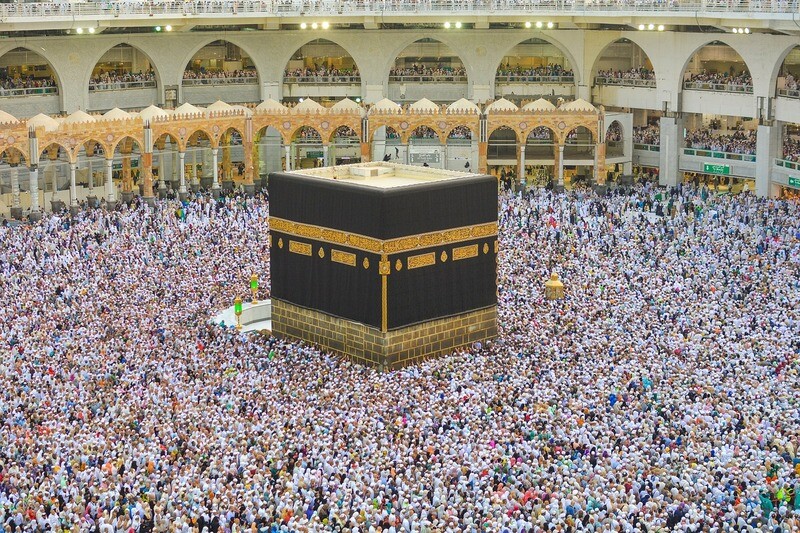Embarking on the timeless pilgrimage of Hajj has transformed over the ages, and we’re about to unveil the fascinating journey of ‘Hajj Changes Then and Now.’ From the sands of history to the digital age, this sacred odyssey has evolved, yet its essence remains unchanged. Delve into the pages of time and witness the shifts that have shaped the spiritual voyage, blending tradition with innovation. As we explore the rituals that have stood the test of time and the modern influences that intertwine with ancient devotion, join us on this immersive exploration of Hajj Changes Then and Now.
Table of contents
The Story of Hajj

Firstly, the origin of Hajj dates back to the period of Prophet Ibrahim. The Prophet’s wife was desperately searching for food after he left her and their son in a deserted land in Arabia. To answer her pleas, God created a spring of water named “Zam Zam” near the foot of the baby. As a remembrance of the sacrifice Prophet Ibrahim made to God, Muslims worldwide sacrifice sheep to celebrate the Hajj festival yearly.
A glimpse of how Hajj has changed over the years

Back in the day, pilgrims walked to the Kaaba to perform Hajj. It was also primarily limited to those in and around the Arab region. Today, millions of pilgrims worldwide gather in the House of God to perform obligatory rituals.
From Hajj being limited to those living in the Arab region, it quickly moved to Africa. With advancements in transportation, Muslims from every corner of the world gather in Makkah to perform the Hajj pilgrimage.
In the earliest days of Hajj, people walked up to the Kaaba to perform religious rituals, which was why only those living close to the site could do it. With the introduction of steamships, more pilgrims from different regions crossed oceans to come to perform Hajj. Finally, with the invention of airplanes, people from every corner of the globe could make it to the holy city of Makkah.
With the advancement in transportation came the additional cost of performing the Hajj pilgrimage. Today, it is something that only the wealthy can do. Besides, some Muslims save up their entire lives to perform this pilgrimage because it is one of the holiest religious observances of Islam. From hundreds to thousands of pilgrims, the number has now reached the millions.
Ensuring the safety of Hajj pilgrims

The government of Saudi Arabia takes extra measures to ensure the safety and comfort of all pilgrims. From fires to stampedes, the Hajj pilgrimage has seen many disasters that caused many pilgrims’ loss of lives. Measures are in place to prevent such things from happening in the future. Further, the Saudi government compares it to organizing the Olympic Games yearly in the same country!
With the onset of the pandemic, the Saudi government did not accept any pilgrims during the period. It is one of the rare times when the Hajj pilgrimage is not performed in a year. After the country started to reopen, the government accepted a restricted number of pilgrims. Now, it is back to accepting millions of pilgrims worldwide.
The journey to Makkah then and now

The journey to Makkah to observe the rituals of the Hajj pilgrimage has changed significantly over the years. In medieval times Hajj pilgrims would gather in cities like Damascus, Basra, and Cairo to reach Makkah in groups. Moreover, caravans with tens of thousands of pilgrims would head to Makkah annually for Hajj. Throughout the years, there have been various issues where others attacked caravans, and security became a significant concern for the authorities.
Although the Hajj pilgrimage dates back to the time of Prophet Ibrahim, the present form of the pilgrimage started during the time of Prophet Muhammad (PBUH). In 632 CE, the Prophet demonstrated the correct way to perform the pilgrimage to all his followers. These rituals are followed to this day when pilgrims gather in Makkah to perform Hajj.
Pilgrims in Arabia traveled to Makkah on camels, a popular form of transport in that era. Pilgrims from the Indian subcontinent and Southeast Asia traveled across the sea in ships to reach Makkah.
Steamships became a mode of transport to each Makkah in the second half of the nineteenth century. It became possible with the opening of the Suez Canal in 1869. Finally, in 1937, Misr Airlines introduced the first airline service for pilgrims to reach Makkah for Hajj. Today, most pilgrims travel to Makkah for the Hajj pilgrimage via airplane.
There have been significant changes in transportation and how pilgrims perform Hajj over the years. Do you know how people did Hajj back in the day and what has changed over the years? Comment below on what you know about Hajj and what to expect for Hajj.

